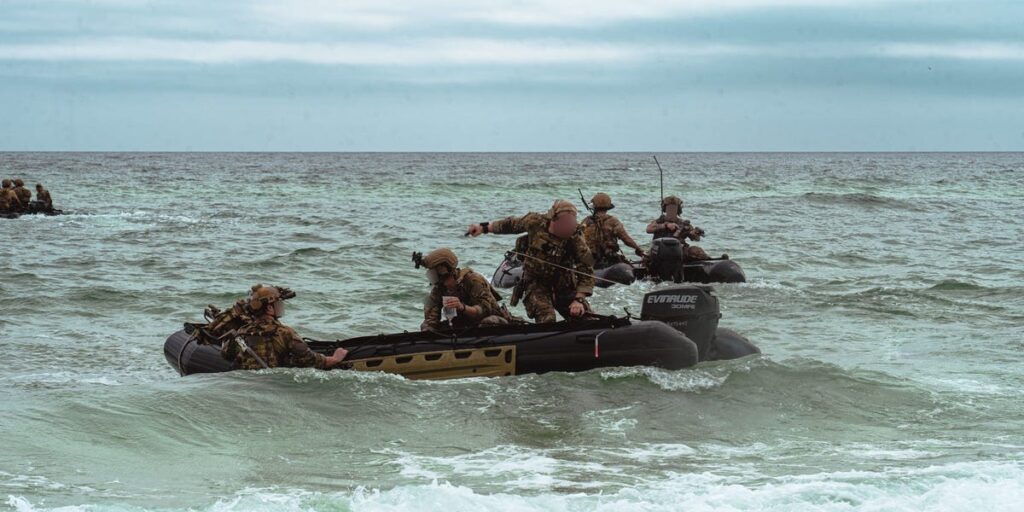- US special operators are shifting away from counterterrorism toward peer-adversary conflict.
- There are five areas the US special operations community can focus on to best do that, new research says.
- These areas harken back to the strengths of special ops in the Cold War and the War on Terror.
As the US shifts its priorities toward countering near-peer adversaries like Russia and China, its special operations forces are adapting to new challenges.
Best practices for that ongoing adaptation may lie in Cold War lessons, new research on how the US can best leverage the skills of the special operations community says.
An Atlantic Council’s report on ways the US can use special operations forces in the next decade was released Tuesday and notes that “three realities” facing the Department of Defense lend themselves to leveraging American special operations forces “more in strategic competition.”
US special operations forces offer critical flexibility amid stagnation in defense spending and force size and can counter aggressors elsewhere while the military prioritizes the Indo-Pacific and Europe. Special operators can also use irregular capabilities to prevent competition from turning into armed conflict.
The report’s authors, Clementine Starling-Daniels and Theresa Luetkefend, argue that US special operations should return to their “roots” and Cold War practices.
“USSOF’s unconventional warfare support of resistance groups in Europe; its support of covert intelligence operations in Eastern Europe, Asia, and Latin America; its evacuation missions of civilians in Africa; and its guerrilla and counterguerrilla operations helped combat Soviet influence operations worldwide,” they wrote.
“During that era, special operations became one of the US military’s key enablers to counter coercion below the threshold of armed conflict,” the authors added, noting they can do the same again now.
Keeping an eye on non-priority regions
Rivals and foes around the world are pulling the US military in different directions. It’s facing threats from an aggressive Russia, a rising and often confrontational China, and joint challenges from increased cooperation between China, Russia, North Korea, and Iran. Threats from non-state actors also remain.
So where do special operations come in?
“While traditional elements of the Joint Force are likely to focus on the Indo-Pacific region and Europe, the DoD can mitigate risks and extend its global reach by leveraging USSOF for persistent, low-footprint operations in under-addressed regions,” the new Atlantic Council’s report says.
These areas include the Middle East, Central Asia, Africa, Latin America, the Caribbean, and the Arctic as prime examples.
US adversaries like Russia and China look to extend their presence and influence in these areas, meaning the Pentagon could use special ops to protect US interests and preserve situational awareness.
Preventing full-blown conflict with unconventional, irregular warfare tactics
To deter conflict, the US military can use special ops to up activities in the cyberspace and information environment that expend adversary resources. Some of SOF’s biggest strengths are in this area, including intelligence campaigns, warping information and communications spaces, unconventional tactics that target US adversaries and create narratives favorable to Washington, sabotage, and deception.
Two prime examples could include supporting Taiwan’s resilience against a potential Chinese invasion or blockade and Eastern European resistance to Russia’s hybrid warfare and disinformation tactics.
During the Cold War, special operations forces conducted similar operations against the Soviet Union, bolstering resistance groups in Europe and undermining Soviet campaigns.
Skills from the Global War on Terror can be applied as well. Over the past 20 years, the US has relied on special operations for unconventional and difficult missions, including running shadowy helicopter assaults to kill or capture enemy leaders. These activities advance national security objectives.
Building connections with key allies and partners
Christopher Maier, the assistant secretary of defense for special operations and low-intensity conflict, said earlier this week that the other strength of special ops comes with its widespread global footprint and cultural awareness, which helps build connections between the US and its allies and partners.
Special ops leaders have long recognized that language and cultural sensitivity are absolutely critical to the force’s success, but a recent watchdog report raised concerns about those skills.
Between 2018 and 2022, most Army and Marine Corps Special Operations Forces didn’t meet the necessary foreign language proficiency goals.
Such skills have been vital for US military cooperation with allies in the past. Us Army Special Forces, the Green Berets, have been training and advising foreign armies and guerrillas since the early 1960s.
Similarly, US special operations cooperation with foreign SOFs is critical, the Atlantic Council paper says, and vital to building resilient relationships with partners that can help deter and deny the influence of US adversaries.
Putting the “integration” in integrated deterrence
US government and military responses to crises and conflict often need to be integrated responses, something special operations forces can help provide, the report argues.
“USSOF operations often bridge the activities of interagency and intelligence community partners, allied and partner militaries, and the rest of the joint force,” the paper says, adding that special operations could be the “connective tissue.”
That special operations “tissue” could connect US government departments like State, Justice, and Treasury Departments, as well as the Central Intelligence Agency and National Security Agency.
Using SOF’s technological prowess to US advantage
Future warfare is expected to span across all domains, including information and cyber. As technological capabilities, such as artificial intelligence, develop at breakneck speed, special operations can play a pivotal role as a “pathfinder for technological solutions that can be scaled across the Joint Force,” the report says.
Such a “pathfinder” role could include facilitating data sharing across the military and government and identifying and fielding cutting-edge technologies, especially in unmanned systems.
SOF’s procurement process and culture has given it the opportunity to quickly develop and deploy innovative technologies and systems before the larger joint force.
That also sets special ops up for focusing on what the demand of future warfare could be, which could “support DoD’s information and decision advantage over its competitors,” the Atlantic Council report adds.
Read the full article here
















